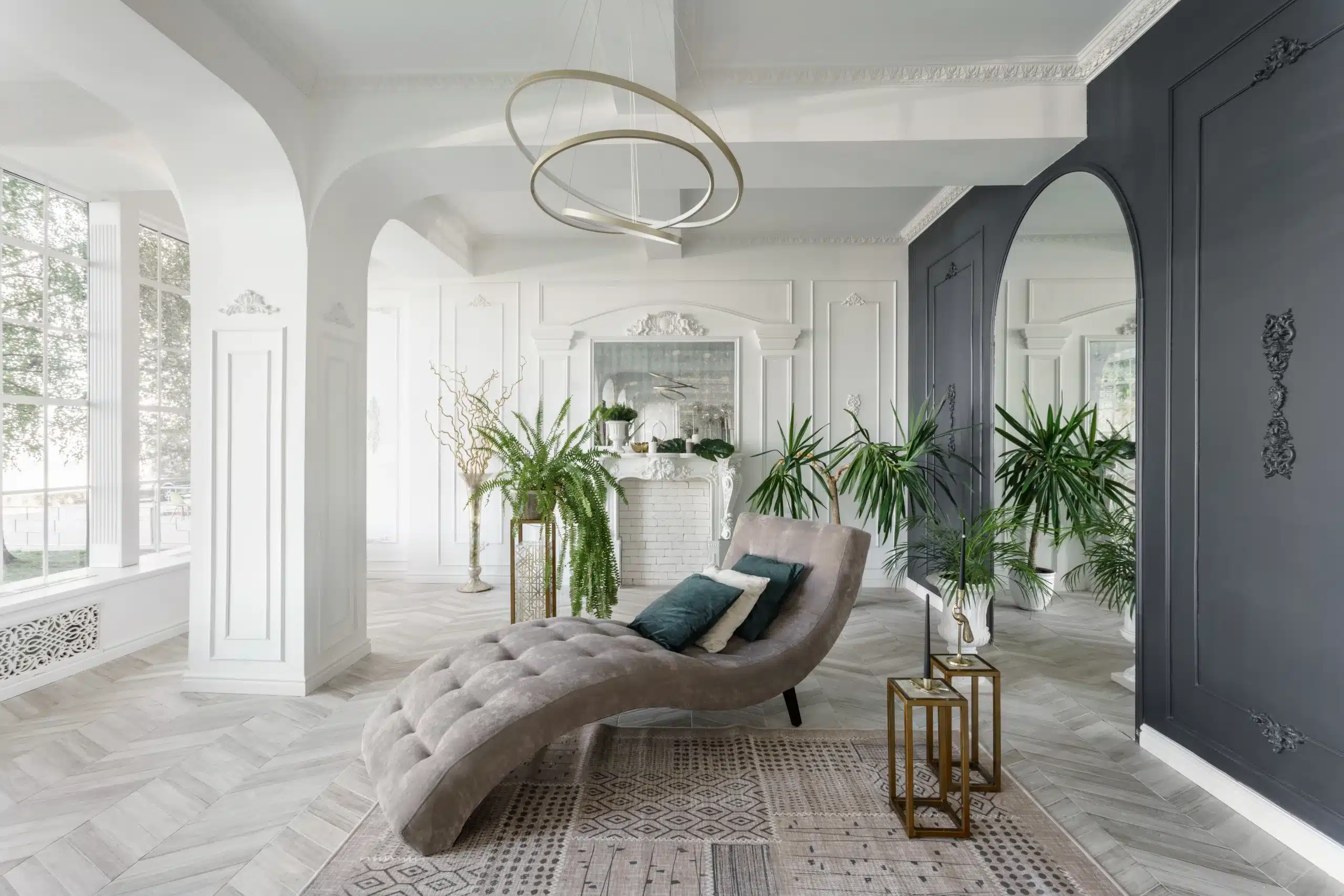The landscape of luxury interior design has always been a showcase of opulence and innovation, but recent years have seen a dramatic shift. The rising influence of technology, sustainability, and a quest for uniqueness have altogether sculpted a new definition of luxury. In this comprehensive exploration, we will unveil the latest trends shaping the high-end interior design world, catering to everybody from the interior design aficionado to the discerning luxury homeowner.
The Green Enclave: Sustainable Luxury
The adage ‘Green is the new Black’ has found a luxurious echo in the domain of interiors. Luxury is no longer solely defined by thread counts or gold leaf–traces but by an ethos of sustainability that resonates with the eco-conscious elite. From reclaimed wood flooring and vintage furniture to biophilic designs and energy-efficient smart homes, sustainability is now an indispensable element of high-end interior design. Today’s wealthiest individuals seek not only the finest materials but ways to reduce their environmental impact. The result is a shift towards a new form of luxury, one that boasts exclusivity while being mindful of the planet.
Biophilic Design
Biophilic design is a concept that marries nature with the built environment, offering a host of benefits from improved air quality to a greater sense of calm. High-end spaces now incorporate living walls, large windows framing breathtaking landscapes, or even indoor greenhouses as a nod to the natural world, creating sanctuaries for modern living.
Sustainable Materials
Luxury interiors are now adorned with materials handpicked for their eco-credentials. Look for sumptuous organic textiles, leather alternatives such as Piñatex or apple leather, and innovative recycled options like glass countertops or porcelain made from industrial waste—elevating eco-friendly styles to new levels of sophistication.
TechnoLux: The Emergence of Smart Luxury
The integration of cutting-edge technology in high-end interior design has given birth to a sophisticated lifestyle where convenience and customizability reign supreme. Smart homes are no longer a concept of the future but an integral part of the present-day luxury abode. From voice-activated systems and integrated lighting controls to motorized furniture and even AI art collections on display, technology is seamlessly woven into the fabric of modern luxury living, offering a new level of comfort and personalization.
Customized Experiences
Technology allows for tailored experiences at a touch, from creating mood lighting that changes with the natural light cycle to personalized climate control and entertainment systems that learn your preferences. It’s this level of bespoke comfort that truly defines the modern luxury home.
Invisible Technology
Aesthetic integrity is paramount in luxury interiors, and here, technology is often invisible. Hidden speakers, retractable televisions, and appliances that blend into the cabinetry are just a few examples of how advanced tech is integrated without compromising the design’s elegance.
Timeless Individuality: Bespoke Elegance
In an age where mass production is the norm, high-end interior design has seen a glorious resurgence of bespoke craftsmanship. More than just a trend, bespoke pieces have a storytelling quality and an unmatched level of craftsmanship that embodies the unique identity and style of the homeowner. Commissioning custom art, handcrafted furniture, and tailor-made fabrics ensures a level of individuality that is, by its very nature, luxurious.
Custom Furniture & Art
Artisans and designers collaborate to create one-of-a-kind pieces that serve as functional art, like a chandelier crafted to mimic the homeowner’s favorite flower or a desk designed around their profession. Custom pieces are becoming the marker of luxury, providing a unique touch that is unparalleled.
Tailor-Made Spaces
The ultimate in high-end interior design is the tailor-made space — a room or home designed from scratch to fit the homeowner’s lifestyle and aesthetic. Tailor-made spaces are an expression of the owner’s personality, with every detail meticulously planned, from the layout and color scheme to the materials and lighting.
Ancestral Modernity: Heritage-Inspired Luxury
While the push for modernity is strong, there’s a counter-trend that values heritage and tradition, particularly among high-end interior design enthusiasts seeking to connect with the past. This ‘ancestral modernity’ draws inspiration from historical periods, reinterpreting classical elements in a contemporary context, and exuding a timeless grandeur that appeals to those who appreciate the depth of history entwined with modern elegance.
Historical Influences
Designs may feature neoclassical columns or Louis XVI chairs upholstered in a futuristic fabrics, offering a fresh take on familiar styles. Historical references evoke a sense of narrative and purpose, creating layers of meaning within a space that are both intellectually stimulating and emotionally resonant.
The Craft of Antiques
Incorporating antiques is one way to bring the past into the present, infusing a space with the stories of bygone eras. Whether a Ming Dynasty vase, a Baroque tapestry, or a Victorian writing desk, antiques bring a level of artistry and craftsmanship that is increasingly rare and, consequently, luxurious.
Illuminating Elegance: The Power of Lighting
Lighting has long been recognized as the unsung hero of interior design, but its role in luxury spaces has never been more pivotal. Modern luxury is defined by an interplay of natural and artificial light that sculpts the environment, enhancing textures, and setting the mood. The latest trends in lighting design emphasize sculptural fixtures, energy-efficient LED technology, and smart controls that allow for intricate lighting scenarios.
Sculptural Fixtures
Lighting has transcended its functional role to become a statement piece, with designers creating fixtures that are works of art in their own right. Chandeliers that resemble glistening constellations, floor lamps that could double as sculptures, and pendant lights that defy gravity are just a few examples of how lighting can be both form and function.
Integrated Light Design
Lighting is meticulously integrated into the architecture and interior elements to create a harmonious whole. LED strips embedded in the ceiling offer a soft, continuous glow, while spotlights highlight key features and works of art. Indirect lighting is a popular choice, providing an immersive, ethereal ambiance that is especially well-suited for luxury spaces.
The Dawn of Minimalism: Effortless Sophistication
Minimalism has long been associated with clean lines and simplicity, but in the context of luxury, it signifies a commitment to quality over quantity and a keen editor’s eye that eliminates all but the essential. This refined approach to luxury interior design values open spaces, uncluttered surfaces, and a limited color palette that allows for a few, carefully selected pieces to shine.
Quality Over Quantity
Luxury minimalism disposes of the excess, opting instead for a collection of the highest-quality materials and craftsmanship. Each piece, whether a sofa or a vase, is chosen with care and consideration, with an emphasis on its design, function, and the story it tells within the space.
The Art of Curation
Curating a minimalist luxury space is akin to composing music — it’s about achieving the perfect harmony and balance. Each object is chosen not only for its individual beauty but also for how it interacts with the surrounding spaces. The result is an interior that feels effortless and serene yet undeniably opulent.
In Conclusion
The renaissance of luxury interior design is a mosaic of varied influences, from a growing consciousness towards sustainability to an increasing reliance on technology for comfort and convenience. Today’s luxury homeowners and design enthusiasts demand individuality, craftsmanship, and a narrative that is as environmentally conscious as it is elegant. By navigating these trends, interior designers and homeowners can transform living spaces into sanctuaries that are not only luxurious but also reflective of the evolving ethos of our time.



